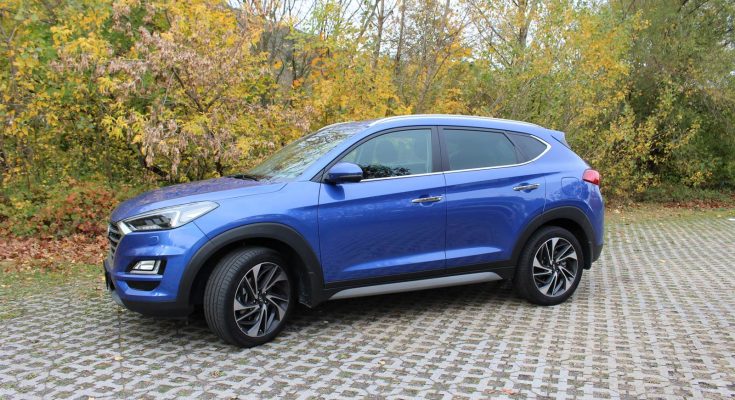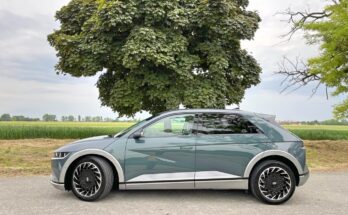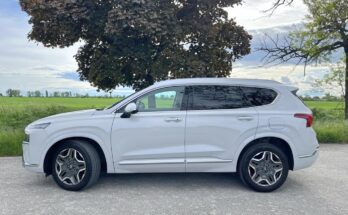Hyundai Tucson is one of the best-selling medium SUVs. It is thanks to the design, useful properties and favorable price. It recently underwent a facelift, which smoothed out the beginning wrinkles, modernized the technology and improved the interior. We test the car in full Premium equipment, with four-wheel drive and, unusually, with a T-GDi gasoline engine.
From the outside
The successful exterior was one of Tucson's strengths even before the facelift, and therefore it was not necessary to make fundamental changes. At the front, the radiator grille has been enlarged, the fog lights have been combined with daytime running lights, and subtle retouches can also be seen on the bumper. The front headlights are fully diode. On the side, a chrome line was added on the lower part of the windows and new, very nicely designed 19" wheel discs. The rear LED headlights have new graphics and thus appear cleaner and more modern. Hyundai, as one of the few manufacturers, does not hide the exhausts in its models, on the contrary, it highlights them with massive angular tailpipes in the Tucson. The distinctive blue color makes the chrome accessories stand out and suits the car extremely well.
Inside
In the interior, I was immediately impressed by the new 8" infotainment display, which is no longer part of the dashboard as in the model before the facelift, but is pulled out in "tablet form" on its upper part. Freeing up space allowed the designers to move the ventilation vents under the display of the multimedia system. Stitched imitation leather added elegance to the interior. The upper part of the dashboard is made of softened plastic, the rest is hard, but looks just as valuable.
The air conditioning panel with a lot of buttons has a nice and, above all, practical effect on me. However, I do not like the blue color of the characters on its display, which is not the most pleasant in the dark and mainly differs from the white color of the characters on the dashboard.
I expected that the steering wheel from the i30 model will be used after the facelift, as the current shape of the steering wheel and the buttons on it are already outdated. However, there is nothing to blame on the functional side. I was happy with the instrument panel with the analog speedometer and tachometer and the TFT display between them. Switching between a lot of information was practically ensured by the buttons on the steering wheel.
The central tunnel provides space for storage and inductive charging of a mobile phone and a number of practical pockets. I was satisfied with the rendering of the automatic selector and associated buttons.
I liked the simple but tasteful door upholstery. However, I have reservations about the cheap material used for the window control buttons and the smooth plastic around them. It is a pity that the manufacturer forgot to cover the thresholds, which can lead to soiling of the pants when crossing them.
The leather (heated and cooled) seats look quite simple. They are without significant shaping and lateral guidance.
Driving
Getting into the car is comfortable. The range of steering wheel adjustment, the excellent position of the pedals and the seat contribute to an almost ideal sitting position. However, I wasn't happy with the seats to begin with. I had the feeling that I was not sitting in them, but on them. I would welcome more pronounced shaping of the backrest and a slightly lower seat. The adjustable lumbar support was placed a bit higher than I would have liked. However, after a while I got used to it and stopped seeing it as a disadvantage.
I appreciate that most of the car's functions are controlled by classic buttons. I admit that it is not easy to navigate in their quantity at first, but after a few days one gets used to it and controls them only by touch. The almost perfect view from the vehicle is spoiled only by the thicker A-pillar. I also praise the large rear-view mirrors.
There is plenty of space in the driver's seat in all directions. The steering wheel has an above-average thick ring and is excellent to hold. The central armrest is not adjustable or sliding, but I liked its location. The infotainment display is within reach and easy to operate. Thanks to Android Auto support, I traditionally used Waze for navigation. However, it was necessary to use an original thick cable to connect the mobile phone to the multimedia system.
On the road
The driving characteristics of the Tuscon positively surprised me. The chassis is noticeably stiff, but still above average comfortable even on 19" (245/45 R19) wheels. The rear multi-element axle does its job perfectly, it does not jump when driving in corners on an uneven surface and keeps the car in the desired direction. The car ignores normal unevenness, and lets you know about bigger ones with a muffled sound. When driving, you could tell in advance how the car would behave. I liked the subtleness of the chassis and the small leans in the corners. I also appreciate the work of the stabilization system, which did not intervene too early and allowed the car to be driven a little more aggressively for SUV conditions. By the way, this was made possible by the engine that powered the tested Hyundai.
It is a gasoline four-cylinder with a volume of 1591 cm3, a maximum power of 130 kW at 5500 revolutions and a torque of 265 Nm between 1500-4500 revolutions. After starting, the engine is exceptionally quiet and vibration-free. I liked his explosiveness and willingness to go into the turns. It provides steady thrust starting below 2000 rpm and ending at 6500. Throttle response is not immediate, but turbo lag is well suppressed. I really liked the engine performance in the Tucson. I consider the gasoline consumption to be a big minus, I consider the value of 10 l/100 km to be too high. With a similar driving style, I completed the same routes with a Mazda CX-5 with a 2.5-liter gasoline engine (194k) and a Skoda Kodiaq with a 2.0 TSI (190k). The difference in fuel consumption in the first case is two liters, in the second case a liter to the disadvantage of the Tucson. Such consumption forces the driver to refuel too often despite the relatively large 62-liter tank. I will come back to consumption, break it down into small details and compare it with diesel motorization.
The engine was coupled with a 7-speed double-clutch transmission of our own production. Similar to the recently tested models of the brand ( Kona , i30 Fastback ), I was extremely satisfied with it. It shifts quickly, logically and starts from a standstill gently and without jerking. He gets along well with the tested unit, does not turn it unnecessarily and uses a wide range of its maximum torque. It tries to keep the speed as low as possible in normal mode, which causes a brief hesitation of the transmission when trying to accelerate rapidly. Sports mode keeps a 1-2 lower gear, which significantly shortens the shift time. Engine responses are immediate and the gas pedal is much more sensitive.
Driving in average dense city traffic pushed the consumption above 12 liters. Other than that, I was happy with the car in the city. A turning diameter of 10.6 meters and a steering wheel revolution between stops of only 2.4 made the Tucson very agile. Compact dimensions and an above-average view helped it to easily push through a lot of cars ahead. Parking was convenient thanks to four cameras providing a 360° view around the car.
On county roads, in addition to the lively engine and decent chassis, I also appreciated the excellent steering, which acts immediately, is stiff, without play around the central axis and relatively direct. However, with the lane assist on, the steering loses its naturalness and struggles a bit with the driver. On the other hand, its ability to follow lanes even in sharper turns is admirable. Assistance systems are traditionally exemplary. As an example of everything, I will mainly mention the excellently functioning adaptive cruise control with the function of autonomous stopping and starting the vehicle. The chassis enables relatively fast cornering, enhanced in sports mode by the engine's quick response to the gas pedal. Even when trying to drive economically, I did not manage to reduce the consumption below 8 liters. I achieved a value of 9.4 during normal brisk driving.
When driving on the highway, I was positively surprised by the low aerodynamic noise and the excellent soundproofing of the chassis. In strong winds, the noise was still acceptable, but its gusts could be felt, which is natural given the height of the car. The engine has enough power even at highway speeds and accelerates sharply to at least 160 km/h. The consumption depended precisely on the strength and direction of the wind and at a speed of 130-140 km/h it ranged from 10.7 to 13 liters. On the expressway at a speed of 100-110 km/h, it did not fall below the value of 8.5.
In the table, I attach the values of the revolutions on the 7th gear at individual speeds:
| Speed in km/h | RPM per min. |
| 100 | just under 2000 |
| 110 | 2100 |
| 120 | 2300 |
| 130 | 2500 |
| 140 | 2700 |
Since I don't consider the journey to be too short, I attribute the high consumption, in addition to the higher weight (almost 1700 kg), mainly to the small volume of the engine. In my opinion, the company's 2.0 T-GDi engine would do a better job, while its performance could be reduced to a similar value as the tested one-six.
Price, equipment, practical side
The price of the tested model is EUR 33,690 (EUR 30,190 + EUR 2,000 for automatic transmission + EUR 500 for metallic + EUR 1,000 for leather seat upholstery). I consider it very acceptable, moreover, it is often reduced by special offers of the importer. At the time of publication of the test, the importer offers a bonus of EUR 1,500 if certain conditions are met, which reduces the final price to EUR 32,190. Of course, there is a 5-year warranty with no mileage limit.
Now I will return to consumption. The Tucson with a comparably powerful diesel engine (136 kW) is exactly EUR 3100 more expensive and achieves a real consumption of 2 liters less than the tested car. At the average prices of gasoline (1.271 EUR/l) and diesel (1.134) as of 23/10/2018, the advantage of the lower price of the gasoline version begins to disappear only after driving 86,000 km.
The equipment is practically complete and will satisfy even the most demanding customer. I was satisfied with the new dipped LED headlights, but the high beams shine too high. However, I believe that it is only a matter of setting in the service. I might have missed the head-up display and seat adjustment memory from the equipment.
A car with a reserve will cover the needs of a family of four. The rear seats are adjustable and comfortable enough. When sitting "behind myself", there was still 5 cm of space left in front of my knees (at 185 cm height). Installation of the child seat is simple, the back of the front seats is "protected" from children by plastic.
Various folders and storage spaces were not forgotten either. A full reserve takes liters from the luggage compartment. Its volume of 488 liters is nevertheless sufficient. There is also an electric socket, hooks for bags and for fixing the net.
Verdict
After the facelift, Tucson became younger on the one hand and matured on the other. It offers an attractive design, a modern and quiet interior, a comfortable and confident chassis and a dynamic, if somewhat thirsty, engine. A well-set price will ensure that the Tucson continues to remain at the top of sales in this increasingly crowded compact SUV segment.




